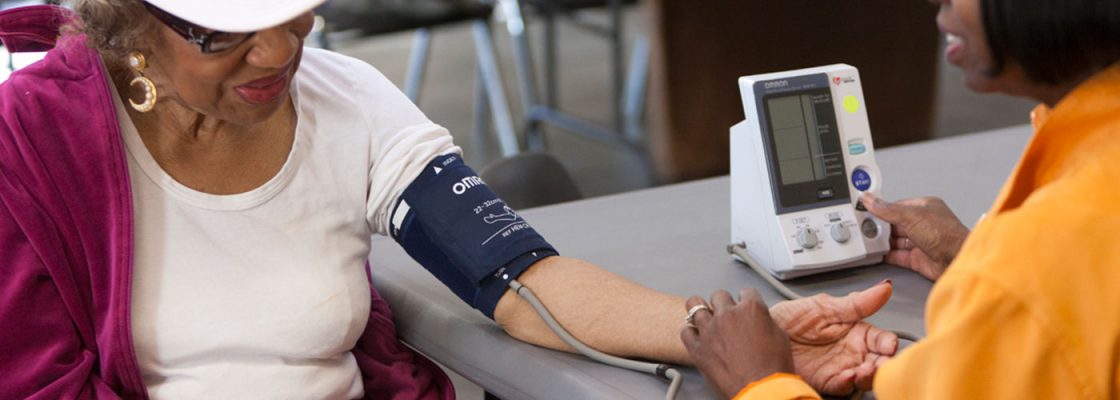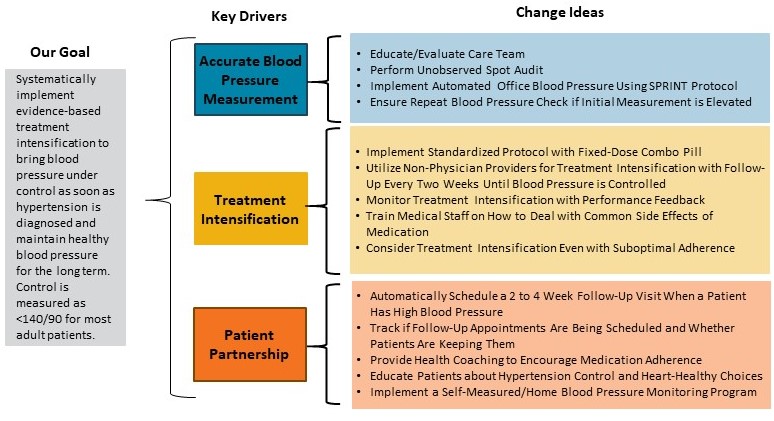What Is a Change Package?
A change package is a collection of “change ideas,” or actions you can take, that are known to produce the desired result in a process or system of care. Change ideas are organized by “key drivers”, or steps required, to transform care. When working with your care team members, think of the key drivers as “what” needs to be done and the change ideas as “how” to do it. Change packages can be summarized in the form of a driver diagram.
The Hypertension Control Change Package
The purpose of this change package is to guide community health centers and other primary care providers in accurately identifying patients with hypertension and applying evidence-based treatment and practices to control it.
This set of change ideas assumes that two important prerequisites are in place:
- Elements of team-based care that allow registered nurses, licensed vocational nurses and medical assistants to work independently according to protocol. For specific strategies and change ideas to implement team-based care, we recommend the Primary Care Team Guide.
- Use of a registry or population health management system to produce reports that allow staff to reach out to, track and follow-up with patients who meet specific diagnostic criteria.
Kaiser Permanente’s successful hypertension treatment program is the foundation of this focused, essential change package, along with input and resources from providers caring for underserved populations. For additional resources related to hypertension control that are broader in scope, visit the American Medical Association’s blood pressure improvement program website and resource library, or consult the CDC’s Million Hearts Hypertension Control Change Package.
| COVID-19 Update
While this change package was prepared according to successful evidence based practices, during this pandemic we realize there are significant challenges to usual care. On the other hand, rapid deployment of telemedicine encounters during the COVID-19 pandemic may have introduced long-lasting changes in how to care for chronic conditions such as hypertension.Where possible, we offer ideas and alternative actions that may help to keep hypertension control efforts on track. The American Heart Association offers this guidance: Keeping a Lid on Blood Pressure During the Corona Virus Crisis, and in a webinar, we heard from Dr. Timothy Ho and Dr. Jeffrey Brettler from Southern California Permanente Medical Group about Kaiser Permanente’s approach during this time. |
How to Use This Guide
This change package is an evidence-based set of changes that, together, ultimately drives successful improvement. It follows the format of a driver diagram, with an overall goal (or aim), key drivers, and change ideas. While each of the three drivers – Accurate Blood Pressure Measurement, Treatment Intensification, and Patient Partnership – is critical, we recommend starting with the first two drivers. Identify any gaps at your organization to ensure accurate diagnosis and focused hypertension treatment. Where there are gaps, you can design interventions to try and close them. Pick a change concept and test it out – adopt it, adapt it, and abandon what doesn’t work. As your team progresses in systematically controlling blood pressure, you can strengthen and sustain the health of these patients by engaging and supporting them in self-care and self-management of hypertension.



